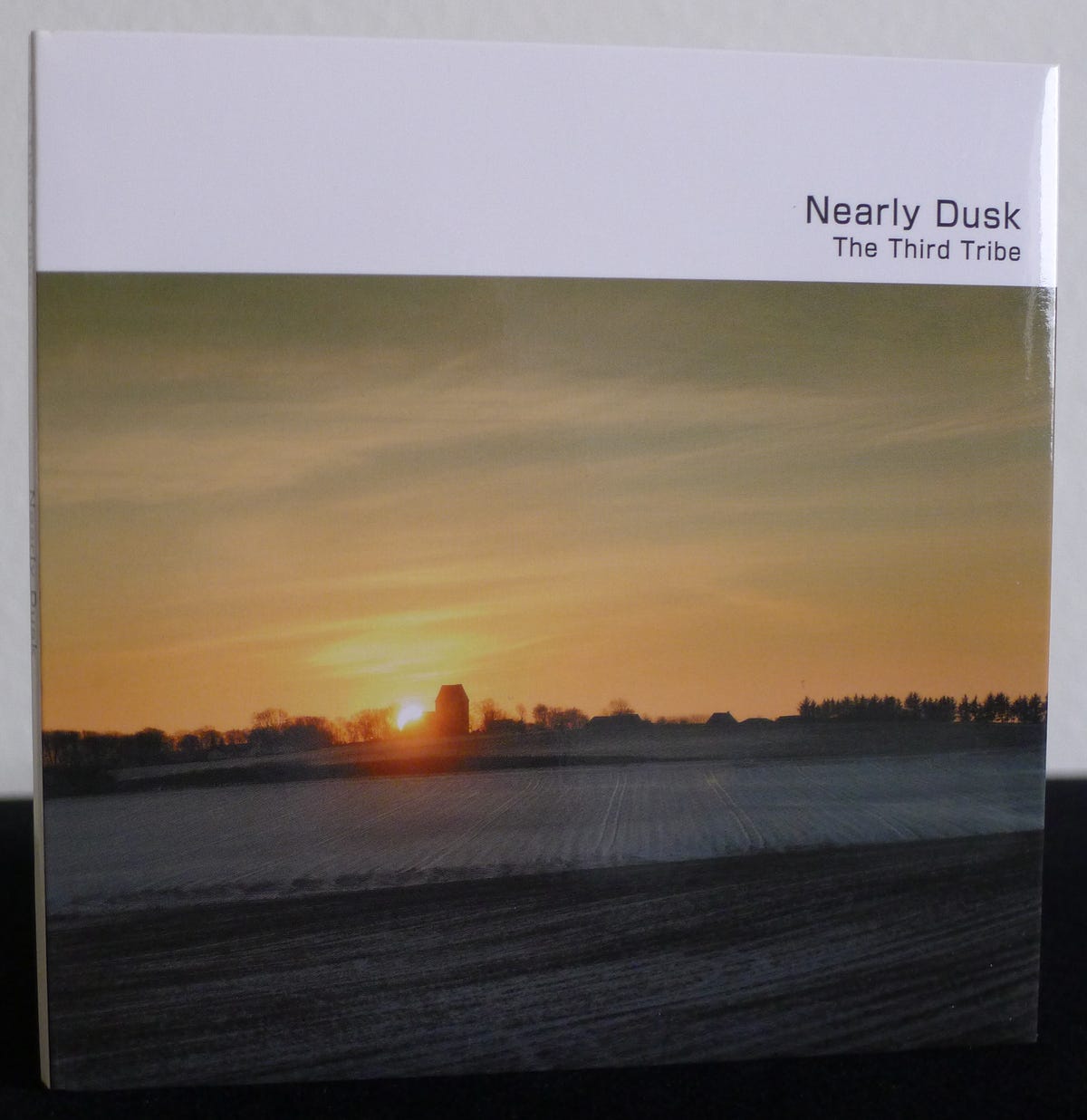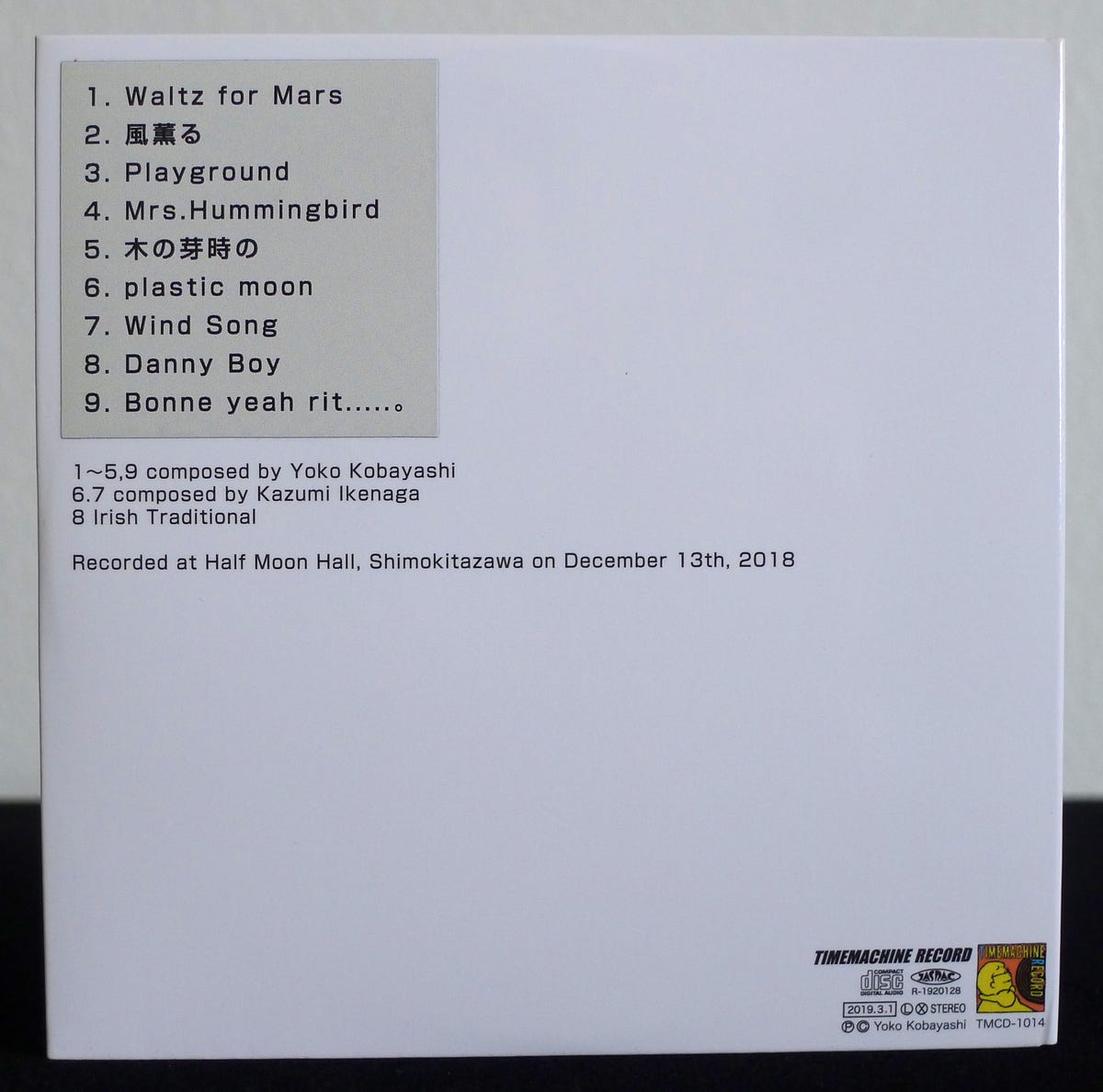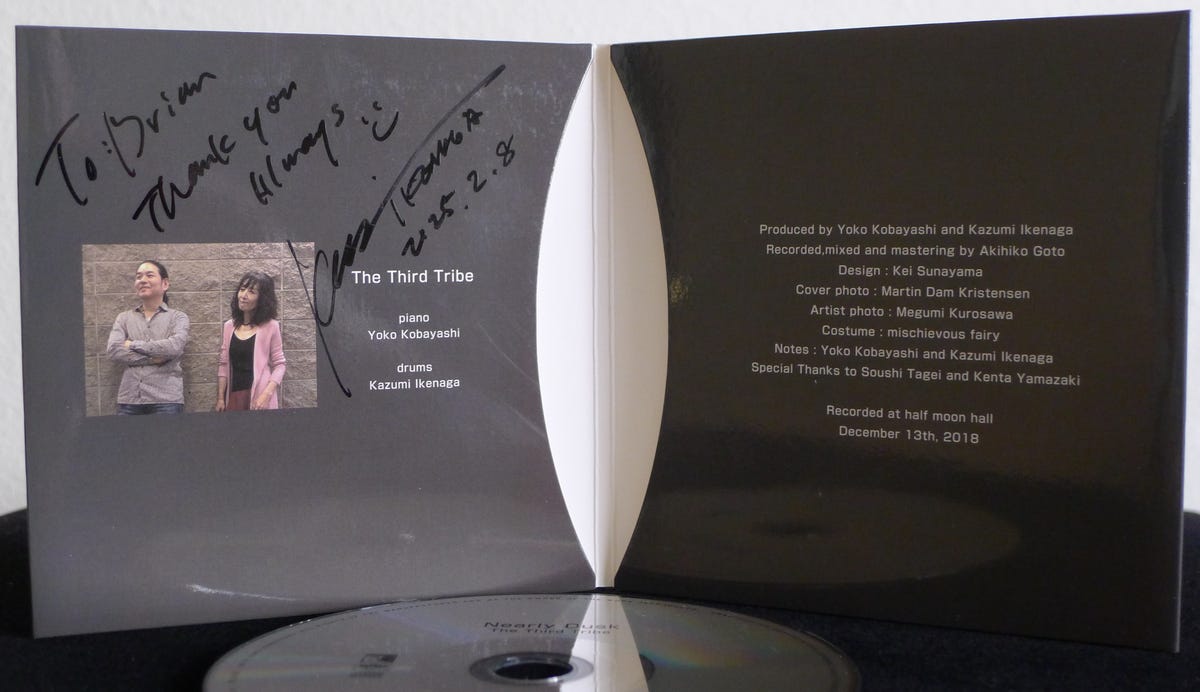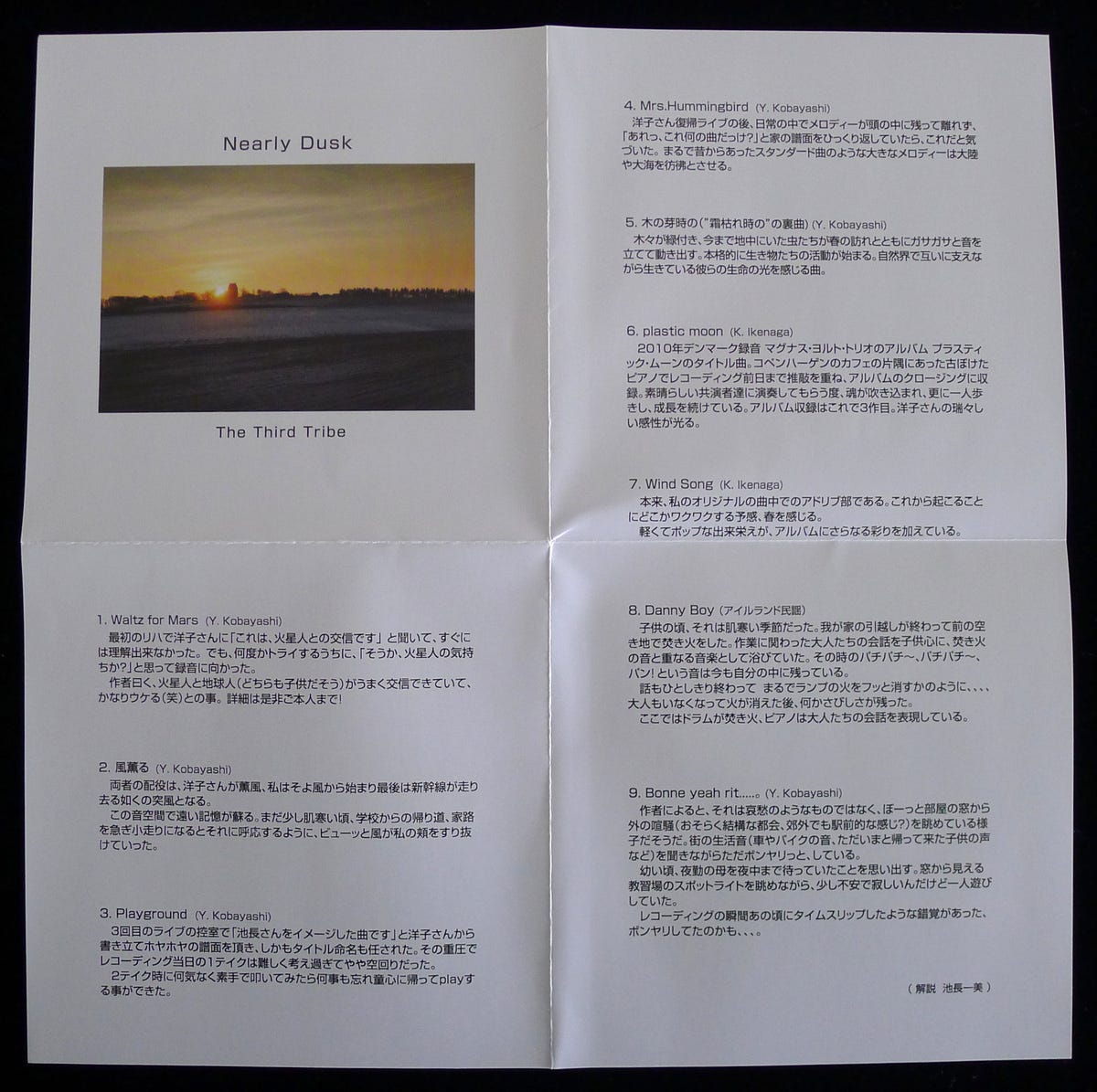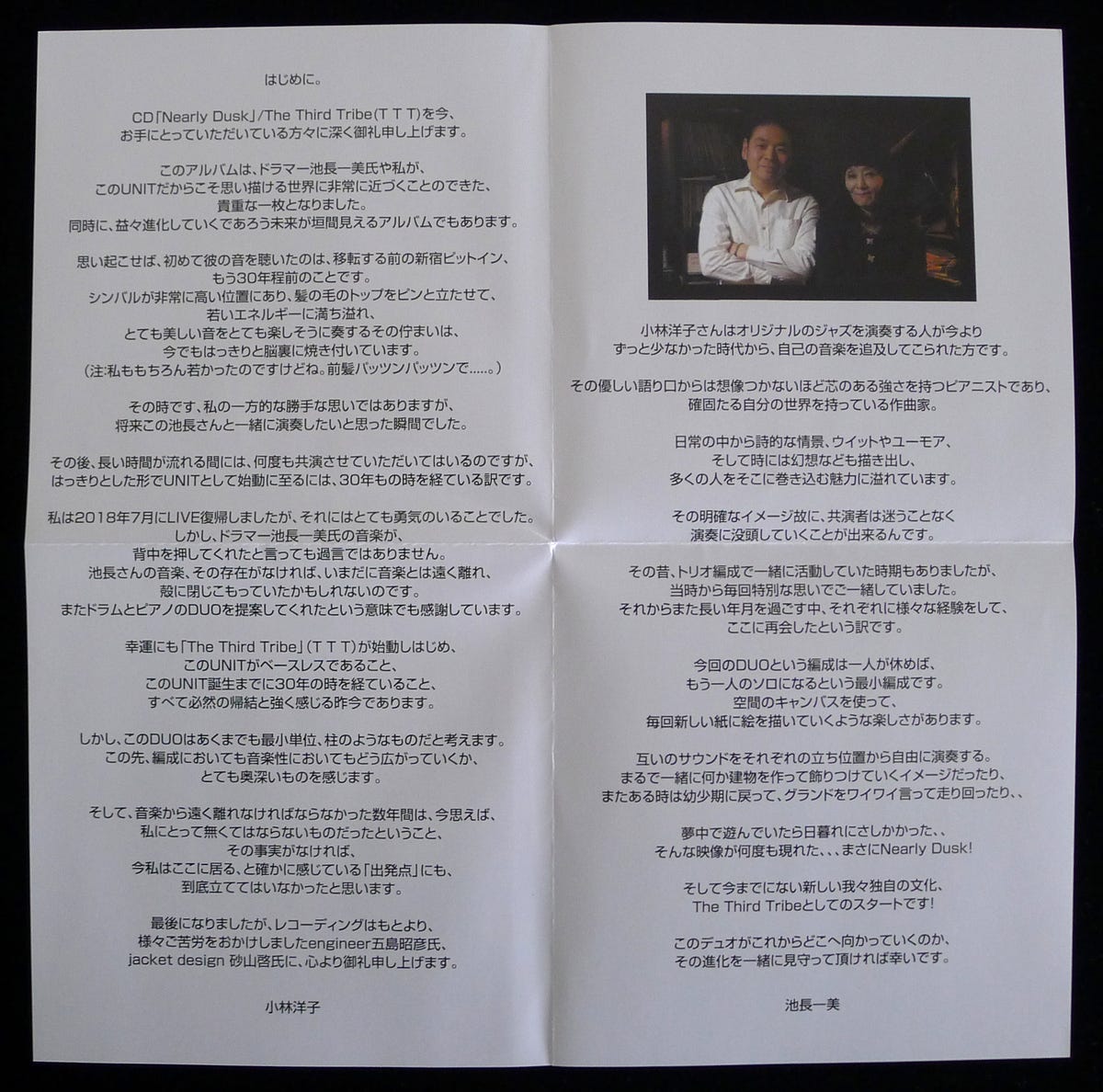The Third Tribe: Nearly Dusk
Almost Dusk is a 2019 album from the duo of pianist Yoko Kobayashi and drummer Kazumi Ikenaga. Their beautifully imaginative music is flexibly arranged, somewhat abstract, but solidly grounded to the music they have written upon which they improvise with linked hands and minds. The duo’s playing roams across their compositions as they tune into to themselves and to one another for in the moment inspiration and stimulation, simultaneously creating, responding, pausing, and reflecting. The written notes of their compositions are also guided by the images and stories that bind the music to their visions, whether it’s signals from outer space, precious childhood memories, or the beauty uncovered in slow daily life.
Liner Notes
(Translated from the original Japanese liner notes and commentary from Kazumi Ikenaga and Yoko Kobayashi.)
1.Waltz for Mars (Y. Kobayashi)
At our first rehearsal, Yoko Kobayashi said “These are communications with Martians.” I didn’t understand that at first, but after trying several times, I thought “Hmm, maybe this is that Martian feeling?” I headed into the recording with that in mind.
According to the composer, Martians and Earthlings (both children, apparently) are able to communicate well, and it’s pretty funny (laughs). For more details, certainly ask the author, please!
2.Kazekaoru (風薫る, Refreshing fragrant breeze in early summer) (Y. Kobayashi)
The two of use play roles where Yoko is a balmy summer breeze and I start as a gentle breeze that turns into a gust of wind like a bullet train speeding away at the end.
This soundscape revives distant memories. Once, on my way home from school, it was still a bit chilly and I started to hurry back on the road home, when a gust of wind seemed to respond and brush past my cheek.
3.Playground (Y. Kobayashi)
In the back room before our third live performance, Yoko gave me a freshly-written sheet music score and said “This is a song that I wrote with you in mind.” She even entrusted me to title the song. I felt the pressure, and I was thinking too hard on the first take of the recording, so I ended up going around in circles.
For the second take, I casually hit the drums with my bare hands, and I was just able to play as I returned to an innocent childlike state, thinking of nothing in particular.
4.Mrs.Hummingbird (Y. Kobayashi)
After Yoko’s comeback performance, a melody got stuck in my head during daily life. I thought, “Oh, what song is that, again?” I turned over some sheet music at home, and I noticed that it was that song. It’s exactly as if it were an old standard from long ago with a grand melody that evokes images of continents and oceans.
5.Konomedoki no (“Shimogaredoki no” no Urakyoku) (木の芽時の [“霜枯れ時の”の裏曲], Early spring [The opposite song of “Dry winter season”]) (Y. Kobayashi)
The trees are green, and the insects that have been living underground start to become active and make rustling sounds as spring approaches. The activities of living creatures begin in earnest. This song captures the light of their lives in the natural world as they support one another.
6.plastic moon (K. Ikenaga)
This is the title track of Plastic Moon, a 2010 album recorded in Denmark with the Magnus Hjorth Trio. We kept fine-tuning the song on an old beat up piano in the corner of a cafe in Copenhagen a few days before the recording, and it was included as the album closer. Every time I can play with these wonderful partners, my soul is enriched, I take further steps forward, and I continue to develop. This is the third album to record this song. Yoko’s lively sensitivity shines through.
7.Wind Song (K. Ikenaga)
Originally, this was an improvised part from an original song. There’s a thrilling sense of excitement for what’s going to happen, and a feeling of spring. There’s also a light, pop-style effect that adds further coloring to the album.
8.Danny Boy (Ireland folk song)
Once during my childhood, we were moving house during the chilly season. After we finished moving, we lit a bonfire in the vacant lot out front. My innocent child’s mind was absorbed in listening to the adults talking about the work combined with the sounds of the fire and of the music. The sounds of crackling…crackling…pop! from that time remain with me.
Once the conversations had ended, it was almost as if a lamp’s fire had been gently blown out… After the adults were gone and the fire had died, a certain loneliness lingered.
Here, the drums express the bonfire, and the piano represents the adults’ conversation.
9.Bonne yeah rit…..。 (Y. Kobayashi)
According to the composer, this does not have a sense of melancholy, but the feeling of looking out absentmindedly from a room’s window and watching the hustle and bustle going on outside (perhaps a big city, or somewhere next to a station in the suburbs?). It is just absently spending time listening to the city noise, such as the sounds of cars and motorcycles, and the voices of children coming home.
I have a memory from childhood when I would wait up late for my mother who worked night shifts. I kept myself entertained alone, feeling a little anxious and lonely while sitting at a window and watching the spotlight of a driving school across the way.
At a moment during the recording, I had the illusion that I had gone back in time to that memory, or maybe I was just daydreaming…
(Song commentary: Kazumi Ikenaga)
Introduction
We would like to express our sincere gratitude to those who have gotten this CD, Nearly Dusk / The Third Tribe (TTT).
On this album, I’ve been able to approach very closely a place that only this particular unit, Kazumi Ikenaga and myself, could imagine. This has became a very precious recording for me. At the same time, this is an album that offers a glimpse into some future evolution.
If I remember correctly, the first time I heard Ikenaga’s music was at Shinjuku Pit Inn before they moved, about 30 years ago. The cymbals were set very high, his long hair was pinned up on top of his head, he was filled with the energy of youth, and was having so much fun while playing very beautiful sounds. The image is still etched in my mind. (Note: Of course, I was also young at the time, and my bangs were precisely cut.)
At that moment, I selfishly thought to myself that I wanted to perform with this Ikenaga-san sometime in the future.
Since then, we’ve performed together many times during those long years, but it’s taken 30 years for this unit to officially begin in its concrete form.
I returned to playing live performances in July 2018, and it was something that took a lot of courage. It’s not an exaggeration to say that the music of drummer Kazumi Ikenaga supported me. Without him and his music, it may have been the case that I remained removed from music, shut away in my shell. I am also so grateful that he proposed the idea that we perform as a duo of drums and piano.
Fortunately, The Third Tribe (TTT) got started. I am convinced that the fact that were are a bass-less unit, and that the birth of this unit was 30 years in the making, are outcomes that were inevitable.
Yet, I think that this unit is just one small part of something, like a pillar. I feel that there is something profound about how this unit may expand, both in terms of composition and musicality.
Reflecting on it now, I think that the several years that I was separated from music were indispensable for me. If that had not been the case, I certainly would not have been able to reach the “point of departure” that led to me where I am now.
Last but not least, I would sincerely like to thank the engineer, Akihiko Goto, for his work with the recording and everything else, and Kei Sunayama for the jacket design.
Yoko Kobayashi
Yoko Kobayashi has been pursuing her own music since a time when there were far fewer people performing original jazz than there are now.
At first, her soft spoken style makes it hard to see the strength that is at her core as a pianist and her firmly established personal vision.
Her work depicts the poetic scenes of daily life, with wit and humor, and sometimes even fantastic illusions, in songs overflowing with charm that draw many people in.
It is this clear image that allows the performers to freely immerse themselves entirely in the performance.
There was a period a long time ago when we performed as a trio, and we shared a special connection every time.
Since then, there were many years that we spent where we each had many separate experiences. Now, this is where we meet again.
This time, it’s smallest configuration of a duo format where when one person rests, the other person performs solo. The canvas of open space allows for the fun of drawing a picture on a new piece of paper each time.
We play off each other’s sounds freely from our own positions. It’s like we’re constructing a building and decorating it together. Or, at other times, as if we’re back in childhood, running around the playground and making noise.
After being so absorbed in playing, the sun starts to set… This vision returned many times… It’s exactly Nearly Dusk!
Now, it’s our new unique culture not seen before, the start of The Third Tribe.
We hope that you will join us to watch how this duo evolves, and where we go from here.
Kazumi Ikenaga
Obi Notes
Here begins the history of a new musical tribe!!!
A prayer to the infinite universe, a completely new duo format and their shocking debut!!
Nearly Dusk by The Third Tribe
Yoko Kobayashi - piano
Kazumi Ikenaga - drums
Released in 2019 on Timemachine Record as TMCD-1014.
Japanese names: 小林洋子 Kobayashi Yoko 池長和美 Ikenaga Kazumi
Related Albums
Audio and Video
“Mrs. Hummingbird” (track #4) — excerpt:



